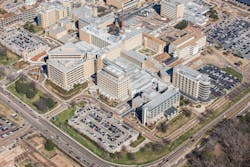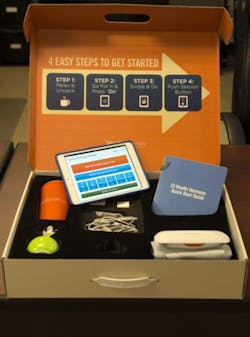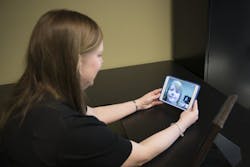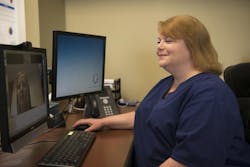Two years ago, Jackson, Miss.-based University of Mississippi Medical Center (UMMC) deployed an innovation remote patient monitoring pilot project, as part of a public-private partnership, to address the growing diabetes crisis in the state, specifically focusing on the rural, underserved population in the Mississippi Delta region. The strong results from that pilot project, called the Diabetes Telehealth Network, prompted UMMC to expand the program to serve thousands of chronically ill and underserved patients across the Southeast.
Mississippi health leaders have been faced some with grim statistics. Mississippi has the third highest diabetes prevalence in the country, with 12.9 percent of Mississippi adults living with diabetes, according to 2013 statistics. In 2012, diabetic medical expenses in Mississippi totaled $2.74 billion, according to the American Diabetes Association. And, 12.1 percent of adults In the Mississippi Delta, among the more underserved and impoverished regions in the nation, reported being diagnosed with type 2 diabetes and 293 died from complications related to the disease. As previously reported by Healthcare Informatics, at the time of the pilot project, the tiny city of Ruleville (pop. around 3,000) had one of the highest rates of diabetes in the country at 13.2 percent.
To launch the Diabetes Telehealth Network back in 2014, UMMC worked with the State of Mississippi, rural-based North Sunflower Medical Center, health IT vendor Intel-GE Care Innovations and telecommunications provider C Spire to coordinate the deployment of remote patient monitoring technology with the aim of improving health outcomes and reducing the cost of care. The pilot project enrolled 100-plus Mississippians living with diabetes and enabled those patients to have timely and consistent access to clinicians through technology in their homes. In the first six months of the project, there was a 1.7 percent average A1C reduction among the enrolled patients and also within that first six months there were zero hospitalizations and no ER visits. While the health outcome improvements are impressive, the program also resulted in cost savings of $339,000 in the first six months due to the reduction in hospital readmissions.
The only academic medical center in the state of Mississippi, UMMC has a history of creating sustainable telehealth models. The organization has been providing telehealth services, via clinician to clinician, since 2003, beginning with a tele-emergency program that connected UMMC Level 1 trauma center physicians with rural emergency rooms. UMMC established the Center for Telehealth in 2013, providing telemedicine services in 35 different specialties in 213 clinical sites across the state, according to Michael Adcock, R.N., administrator for the Center for Telehealth at UMMC. However, the Diabetes Telehealth Network was UMMC’s first program to use remote patient monitoring (RPM) technology to engage patients in their own homes with the aim of connecting the care continuum.
UMMC has extended its collaboration with lntel-GE Care Innovations and will use the vendor’s Health Harmony telehealth solutions platform to serve patients across the Southeast living with chronic conditions, such as diabetes, heart failure, COPD, asthma and hypertension. UMMC’s goal is to enroll 1,000 patients each month both in and out of state by the end of 2016. UMMC officials are anticipating that the remote management programs will save $189 million in Medicaid each year just with the diabetic population.
Healthcare Informatics Assistant Editor Heather Landi spoke with Adcock about UMMC’s successful use of remote patient monitoring technology to improve health outcomes for patients living with chronic disease and the lessons learned from the pilot project as the organization works to expand the program.
The remote management pilot project resulted in impressive health outcome improvements and cost savings. To what would you credit the success of the initial program?
One is obviously having technology that works in places like the Mississippi Delta with patients who don’t have a lot of technical experience, so technology that’s easy to use is certainly a huge piece of how the program works successfully. The patients are given a mini iPad or tablet and peripheral devices, such as glucometer, and they have daily healthy sessions. They are asked a series of questions and they take their biometrics and its uploaded automatically, so the patients don’t have to enter data, and it’s sent to clinicians at the Center for Telehealth. The patients enrolled in the program get small daily doses of education about their disease state that allows them to absorb that knowledge and practice it and use it. The patient can also talk to a clinician or do video visits if there is something they want the clinician to see, for example, there was a patient that had a foot ulcer and, through a video visit, they were able to avoid an ER visit.
Michael Adcock, R.N.
Another factor that sets our program apart from some of the other monitoring programs that are out there is that we are not just monitoring. The purpose of our program is to engage the patient, to empower them to take care of themselves and educate them on their disease process. I’m a nurse by training and when we used to discharge patients, we would go in with a stack of papers and walk the patients through the educational information about their disease. We would then ask them if it makes sense, and the patients would nod their heads ‘yes’ and we moved on. That’s not the most effective way to educate someone. This program actually gives them education in bite-sized pieces that’s repetitive and on a level that they understand; so they learn about their disease and, most importantly, learn to manage their disease themselves. The whole goal of this program is education, engagement and empowerment to create behavioral changes. We want them to, eventually, manage their disease process without the use of technology. Evidence shows that with this type of program, the majority of the behavioral changes will happen within the first four to six months. So it’s education and immediate intervention to help empower change.
So, patient engagement, and enabling self-management, are key pieces of this program, is that correct?
I don’t want to downplay the importance of the clinicians. Their immediate intervention is huge. You can’t control chronic disease through an order, you have to work with patients and help them to understand why they need to do certain things and how it impacts them, and that’s what this program has helped to do. In Mississippi, in general, and in the Mississippi Delta specifically, there is limited access to specialists, as these are patients that don’t have the means to drive an hour or two hours to Memphis or to Jackson. With the first 100 patients within the first six months, we found nine diabetic retinopathies that wouldn’t have been found otherwise because we were able to do ophthalmology through telehealth. The technology is important, the intervention is important, the education is important; it’s everything coming together in a way that makes sense to patients and that we can understand as clinicians.
Care Innovation's Health Harmony kit for patients
What is the feedback you’ve gotten from physicians about the program?
Primary care physicians are now getting trended information. They have access to the raw data and can look at it whenever they want to, but what we send them on a routine basis is actually trended information, which is what they really want as it helps them make decisions. That information goes directly into the electronic health record so they get trend data on blood sugar levels and medication compliance, on a daily basis. We immediately contact the primary care physicians if something goes outside protocols. The feedback we’ve received so far is that the data they receive is exactly what they need. And we’re trying our best not to overload them with data, and that’s why there are protocols.
The pilot project was a public-private partnership and you are continuing to partner with Care Innovations as you expand the program. So, how did working with a technology vendor impact the implementation of the program?
I think having that expertise was very helpful, as [Care Innovations] obviously already had the platform and were involved in remote patient monitoring. We have the ability to build content from a clinical standpoint and we certainly have connectivity expertise from connecting to all these different places, but actually being able to have a format and a platform that works outside of a healthcare setting in patient’s homes is something that is extremely unique. If we didn’t have this partnership with a vendor like Care Innovations, I think, if we tried to do this ourselves, we’d still be trying to figure out how to get this technology into patients’ homes.
Is that a big challenge for healthcare providers, getting the technology into patients’ homes?
It’s certainly a challenge. There are connectivity issues, and that’s how C Spire helped. As you can imagine, Mississippi is a very rural state, and the Mississippi Delta is as rural as it gets—it’s low, flat and wide open and there’s a lot of poverty in the Delta. By working with C Spire and through this project, the connectivity in Mississippi and in the Delta has improved tremendously. So being able to get the technology into the homes and being able to have technology that is patient-centered and intuitive, I think that’s a big piece, because, from what we experienced, a lot of patients in the Mississippi Delta had very limited technical knowledge, if any. There were actually patients who graduated from this program who had never touched a device, never owned a computer, have never done anything on the Internet, and they were able to not only understand the technology but were using it daily. And now they are some of our biggest champions and are now blogging about program. Having that expertise to be able to engage the patients and make it work in patient’s homes, the impact of that was immeasurable.
The technology enables patient-clinician video visits
What were some of the lesson learned during the pilot that will help you as you expand the program?
During the pilot project, the tablet that we used with patients in the Mississippi Delta was a larger tablet, which wasn’t as portable, and that’s something that has changed, so now patients get iPad minis. And, originally with the program, with some of the devices, such as the scales or glucometers, were tethered by plugs and wires, and that gets complicated for patients. The least amount of technical things that we need the patients to do, the more likely they are to comply with the program. So now, all they have to do is push a power button on a glucometer and stick their finger.
Why did you decide to expand the program both in and out of state?
When we first started rolling this program out, I thought we would have to be out selling this program, but it’s actually coming the other way. There has been persistent interest from other hospitals and health systems, employers, health plans and physician practice groups looking to employ similar remote management programs among their respective populations. They see the tremendous cost savings and health improvements and that benefits everybody.
There is a lot of work that goes into making these programs successful. That’s why we’re having success with organizations partnering with us, as we’ve built the expertise, with 13 years in telehealth. The beauty of telehealth is that whether the patient is in Alabama or Alaska, if I can connect them through cellular technology or Wi-Fi to the Internet, I can monitor those patients anywhere.
UMMC's Center for Telehealth clinicians
So we’re currently working with independent providers and payers, in and out of state, to look at patient populations and identifying certain patients to enroll in the program. AT UMMC, through our telehealth and RPM services, we’re able to focus on diabetes and pediatric diabetes, as well as congestive heart failure, COPD and hypertension. After that we’re looking at asthma and even neonatal uses, so patients who graduate from the ICU but still need to be monitored from a weight standpoint. So there are many new and exciting things going on with the expansion of the program. I see the benefit for patients outside of Mississippi and throughout the country for programs like this. We’re going to try to address as many of the healthcare outcome needs as we can. Our program will continue to innovate as we try to find the solutions that help patients improve their health.
What is your perspective on state and federal policies regarding reimbursement for telehealth services?
If you look at how states perform nationally on telehealth reimbursement, Mississippi gets an A rating. From a state standpoint, we have great legislation and it’s nation-leading. We’re in communication with our federal delegation and the federal legislation that they’re trying to push out, the Connect for Health Act, will help us tremendously from a federal standpoint, So right now, Medicare does not pay for remote patient monitoring, and Medicare also limits where telehealth will be paid for based on geographic language. So if you’re in an urban area, Medicare doesn’t pay for telehealth, but for rural areas, they will. Access to care is not limited solely to geographic means. There are people in cities all over the country who do not have access to care and it shouldn’t be based on urban versus rural. We are currently pushing for as much help as we can get on the federal landscape.






